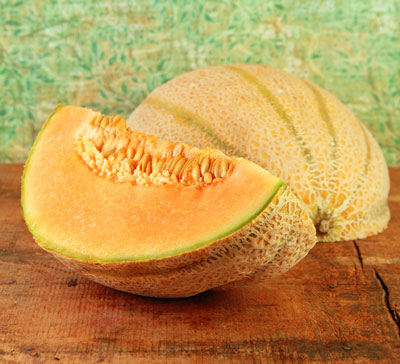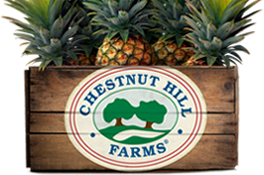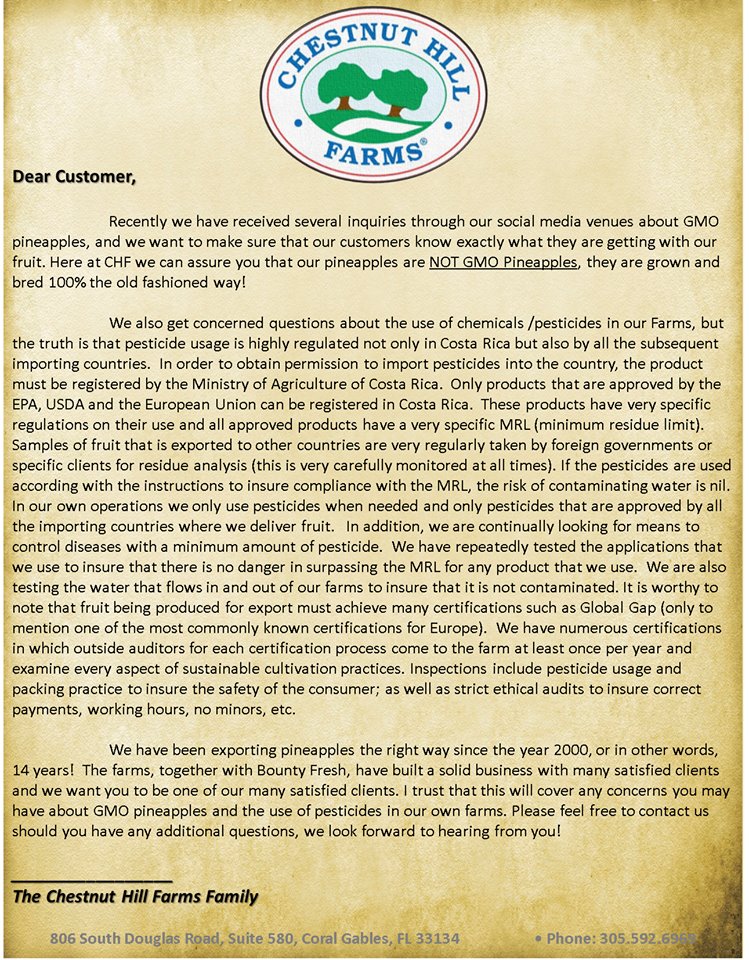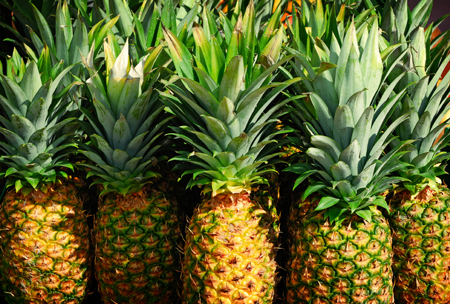-
Featured Posts
- St. Patrick’s Day Pineapple Punch
- Sheet Pan Perfect Pineapple Ham
- Can A Pineapple Really Live Under the Sea?
- Say Aloha to Our Hawaiian-style Ham and Pineapple Pasta Recipe
- Holiday Joy, Hanukkah, and Pineapple Kugel
- What are China’s Pineapple Science Awards?
- Fuel Up with Paleo Pineapple Fried Rice
- Best Gluten-Free Pineapple Upside Down Cake
- Piña Colada Pie in a Jar
- Slow Cooking Your Pineapple This Fall
Tips & Tall Tales
September is Fruits & Veggies – More Matters® Month!
By Dr. Lloyd Berg, PhD.
September is Fruits & Veggies—More Matters® Month and our partner
Produce for Better Health Foundation (PBH) is celebrating by providing a ‘Fuel Up with Every Form’ toolkit for helping Americans increase fruit and vegetable consumption for better health. The kit provides everything from important nutritional facts for every day practice to fun and easy recipes for at-home meal planning. For starters, here’s the Top 10 Reasons to Eat More Fruits & Veggies:
10. Color & Texture
9. Convenience
8. Fiber
7. Low in Calories…
To continue reading, visit Fruits & Veggies More Matters page.
Needless to say, pineapples are among the fresh fruits that help make up a
healthy diet and lifestyle. Make sure to add a pineapple to your cart today in
celebration of this month’s fruit festivities!
Interested in fueling up with more fruits and veggies this month? Visit this
website, here.
For more information about Chestnut Hill Farms and its dedication to increasing
pineapple consumption, please contact us at info@chfusa.com.
Posted in Featured, Latest News, Recipes, Tips & Tall Tales
The Truth About Pineapple “Seeds”
Growers that cultivate pineapple often use the word “seed” for the sucker that is used for planting but this is the incorrect use of the word “seed”. Pineapples do occasionally produce true tiny black seed just below the peel of the fruit which can be found when the fruit is peeled but, in general, pineapples are highly self-incompatible (a general name for several genetic mechanisms in angiosperms, which prevent self-fertilization and thus encourage outcrossing. In plants with SI, when a pollen grain produced in a plant reaches a stigma of the same plant or another plant with a similar genotype, the process of pollen germination, pollen tube growth, ovule fertilization, and embryo development is halted at one of its stages, and consequently no seeds are produced. SI is one of the most important means to prevent selfing and promote the generation of new genotypes in plants, and it is considered as one of the causes for the spread and success of the angiosperms on the earth). Hummingbirds, when present, are the usual natural pollinators but most often when the pollen germinates on the female part of the flower known as the stigma, it usually does not grow through the style and fails to fertilize ovary. Despite this self-incompatibility the fruit will still develop because pineapples are parthenocarpic which means the fruit goes ahead and develops without fertilization of the ovary. Most fruits require fertilization for fruit development. Another example of a parthenocarpic fruit is bananas.
The tiny black seeds that can be found occasionally can be grown into a pineapple plant but it is a very slow process. I have grown them using two plastic glasses. I put soil in one glass and place the seed on top of the soil and cover them with a very thin layer of soil and then carefully moisten the soil (not to the point of saturation). I then invert the second clear plastic glass on tape it to the top of the glass with the soil to form a miniature greenhouse. After 2-3 weeks you will see very small green leaves emerging from the soil. It will take several months to obtain a plant large enough to plant into the ground or a large pot to eventually produce the fruit.
This time consuming process is the reason that commercial pineapple growers use suckers to plant in the field. In a commercial operation, after the fruit is harvested some of the axillary buds that are at the base of every leaf of the pineapple plant will begin to develop into small pineapple suckers which will be large enough to plant in the field in a couple of months. We incorrectly call these suckers “seed” they should probably really be called “daughters”.
Posted in Featured, Latest News, Tips & Tall Tales
COMBATING RHEUMATOID ARTHRITIS WITH PINEAPPLE
Taken from “Fresh Plaza” published 23/10/2012
Pineapple, which is one of the most abundant fruits in Paraguay can help reduce the pains that are caused by rheumatoid arthritis. The results of two nutritionists have shown that it can reduce 100% of the pain.
Rheumatoid arthritis (RA) is an incurable disease that is characterized by a chronic inflammation that affects the synovial membranes of multiple joints like fingers, wrists, elbows, shoulders and knees.
The purpose of the research carried out within the framework of the thesis of Liliana Enciso Lara and Clara Deleon Farina who now have their licenses in Nutrition from the National University of Asuncion was to find a natural solution to reduce the pain caused by RD.
On the basis of experimental research in Europe with synthetic Bromelain which provided satisfactory results when applied to rats, the two young women decided to try the same recipe in patients with arthritis with natural Bromelain from pineapple and the results were very promising.
Clara Deleon indicated, “The AR is not cured, but we looked to relieve the pain of the disease with something natural.”
The research was conducted with 31 adult patients with RA in the Institute of Social Welfare (IPS) that followed an identical pharmacological treatment for three months and pineapple was included in the routine in the fourth month for 30 days.
The results were striking!!
The pain caused by the AR was entirely reduced. The activity of the disease was stopped in 94% if the patients. The morning stiffness in the joints declined 86 percent. These are the most outstanding results of the research, which was able to significantly improve the condition of the patients.
HOW DID THEY DO IT?
Bromelain should be taken daily at a dose equivalent to 7 milligrams for every kilogram of weight of the patient.
Assuming a standard weight of 70 Kg, approximately 150 grams of pineapple should be consumed daily in the morning, which is equivalent to one to two slices of pineapple, depending on the thickness.
The pineapple was given in portions carefully calculated as indicated above. The patients were also called each morning to remind them to eat their pineapple. The satisfaction was that the patients realized the improvement and did not fail to eat the pineapple and often forgot to take their drugs against pain and inflammation. This was the obvious benefit that was noted.
The two nutritionists were completely satisfied with the results of the trials and have maintained contact with the patients who continue eating their portions of pineapple
Posted in Latest News, Tips & Tall Tales
Health Benefits of Eating Pineapples
Perhaps most people eat pineapple because it is truly a fantastic tropical experience of satisfaction resulting from the juicy balance of sweet and acidic tastes without realizing the many health benefits of eating this fine fruit that is available the entire year.
Vitamin C
The health benefits are relatively numerous. The variety MD2 which represents the majority of pineapple now commercially available in the market is high in Vitamin C. This vitamin is the body’s primary water-soluble antioxidant defending the aqueous areas of the body against free radicals that attack and damage normal cells. These free radicals promote the artery plaque build-up of atherosclerosis and diabetic heart disease, cause the airway spasm that leads to asthma attacks, damage the cells of the colon so they become colon cancer cells and contribute to the joint pain and disability seen in osteoarthritis and rheumatoid arthritis. Diets rich in vitamin C have been shown to be useful for preventing or reducing the severity of all of these conditions. In addition, vitamin C is vital for the proper function of the immune system, making it a nutrient to turn to for the prevention of recurrent ear infections, colds and flu. Because of the Vitamin C content, eating pineapple or drinking the juice has the same benefits as drinking orange juice.
Manganese
Pineapple is also an excellent source of manganese, which is an essential cofactor in a number of enzymes important in energy production and antioxidant defenses. One cup of pineapple supplies more than 100% of the DV for this very important trace mineral.
Another of the benefits of Manganese is that it helps to build healthy bones and connective tissues. The benefits of pineapple can effect the growth of bones in young people and the strengthening of bones in older people.
Thiamin
Pineapple is also a good source of thiamin. Thiamin is a B vitamin that acts as a cofactor in the enzymatic reactions central to energy production. In other words Thiamin will boost your metabolism helping your body convert carbohydrates into energy.
Sight degeneration
Our Mothers always said, eat your carrots if you want to keep your eyes bright. It turns out that 3 portions of fruit daily like pineapple may lower your risk of age-related macular degeneration which is the primary cause of vision loss in older adults. Pineapples contain a lot of beta-carotene that is good for the eyes and vision. Three portions of fruit may sound like a lot, but just try putting pineapple in your cold slaw, carrot salad, yogurt, or just make a smoothie. Remember, that the new USDA recommendations are that one half of your plate should be fruits and vegetable.
Bromelain
Bromelain is a group of protein digesting enzymes. Originally it was thought that this group of enzymes was basically limited to help with the digestion in the intestinal tract. For example, it is reported that eating one slice of pineapple after each meal will reduce gas, bloating, nausea, constipation and the symptoms of irritable bowel syndrome. More recent studies have shown that bromelain has a wide variety of health benefits which are probably not related to these enzymes. Excessive inflammation, excessive coagulation of the blood and certain types of tumor growth may all be reduced by therapeutic doses of bromelain when taken as a dietary supplement.
Regular ingestion of ½ cup of fresh pineapple daily is purported to relieve painful joints common to osteoarthritis due to the anti-inflammatory activity of bromelain
Bromelain has been shown helpful for upper respiratory tract infections such as Sinusitis and Bronchitis. It helps to reduce nasal inflammation and break up the mucus in the nasal, sinus, and respiratory area.
Bromelain has also been shown to reduce the risk of blood clots thereby preventing heart problems.
Marinating meat with pineapple juice acts as a tenderizer. By the same form, it will aid in digestion of meats if taken after eating. In addition, pineapple is high in fiber important for healthy digestion. Fiber has also been shown to lower blood cholesterol, control blood sugar.
To Healthy Living,
Dr. Lloyd
Posted in Latest News, Tips & Tall Tales
Dehydrate Your Own Pineapples!

Here is how to dry your own pineapple at home from a fresh one:
– Wash the fruit and cut it into thin slices.
– Lay it on a parchment covered cooking sheet making sure that fruit slices do not touch each other and then place the tray of fruit in the oven.
– Turn the oven on very low setting (150-200 degrees F / 50 degrees C) because we only want to dry the fruit, not to cook it.
– The drying process will take several hours so do not try to increase the heat to speed up the drying process.
– Remove from the oven when fruit is sufficiently dehydrated. Fruit should be chewy, not crunchy or squishy.
– Other method is to put the slices of pineapple in a dehydrator on medium setting for 24 to 36 hours.
Enjoy it!
Dr. Lloyd
Posted in Featured, Recipes, Tips & Tall Tales
Calorie Confusion Remains
Only nine percent of Americans can accurately estimate the number of calories they should consume in a day for a person of their age, height, weight, and physical activity. Additionally, almost half of Americans are unable to provide an estimate of how many calories they burn in a day (60 percent offer inaccurate estimates). Furthermore, the majority of Americans do not keep track of calories consumed or burned, citing numerous barriers, including extreme difficulty and a lack of interest, knowledge, and focus.
Americans are More Receptive to Positive Food Messages: Despite the popularity of some “food rules” which suggest certain foods to avoid, Americans more and more say they would rather hear what to eat (63 percent) instead of what not to eat. The interest in positive messaging rose seven percent since 2009 when the Survey last polled Americans on this sentiment.
Source: International Food Information Council Foundation 2011 Food & Health Survey
So in attempt to kill two birds with one stone (figuratively of course!) here’s a “novel” idea: Reduce Calories by Eating More Fruits & Veggies!
And and if you’re really feeling it, you can even take the pledge here!
Posted in Featured, Tips & Tall Tales
Fresh Facts About Cantaloupe

For consumers 59 and up, the time to sell cantaloupe is ripe! According to this year’s Fresh Trends, the likelihood of a cantaloupe purchase increased according to age and income (which was the same last year). The consumers most likely to buy were age 59 and older.
Cantaloupe was one of the few commodities studied that showed consumers without children at home were more likely to make a purchase than those with kids. The likelihood of purchase amongst shoppers with kids increased according to the number of children.
Married consumers were 43% more likely to buy cantaloupe than single shoppers – the group least likely to buy overall. Western shoppers were more likely to buy the orange–fleshed melon than those in other regions, as was the case last year.
Consumers prefer conventionally grown cantaloupe. In fact, the melon was the number 1 commodity that shoppers bought as conventionally grown. Ten percent of cantaloupe shoppers said they purchased organic product at least some of the time, while 3% said they always bought organic. Single shoppers and those age 23-39 were most likely to buy organic cantaloupe exclusively.
Source: Fresh Trends 2011 – thepacker.com
Posted in Latest News, Tips & Tall Tales
Some Thoughts on Customer Service
A customer service experience can change the entire perception one has of your organization. And no matter what your job title says, you’re in the customer service business.
Bob Dylan said it best:
“You may be an ambassador to England or France
You may like to gamble, you might like to dance
You may be the heavyweight champion of the world
You may be a socialite with a long string of pearls
But you’re gonna have to serve somebody, yes indeed
You’re gonna have to serve somebody
So whether you’re selling directly to the customer or selling to the boss, we think you’d enjoy “Nine Steps Towards Handling Customer Complaints”
Posted in Tips & Tall Tales
What is the origin of the pineapple as a symbol of hospitality
The pineapple has served as a symbol of hospitality and warm welcome through the history of the Americas.
Christopher Columbus wrote the first account of a western encounter with the pineapple in the journal of his second discovery voyage across the Atlantic. He and his men landed on the Caribbean island of Guadalupe where the sailors enjoyed this sweet, succulent new fruit, which had already become a staple of native feasts and religious rites. In 1493, Columbus first brought the pineapple back to Renaissance Europe that was largely devoid of sweet foods, including fresh fruit. The pineapple’s exotic nature and sweetness soon made it an item that soon acquired both popularity and curiosity for centuries after its European arrival. For two centuries, as European horticulturists struggled to perfect a hothouse method for cultivating pineapples in Europe, the pineapple became even more a coveted commodity. In the 1600s, King Charles posed for an official portrait while receiving a pineapple as a gift.
Posted in Tips & Tall Tales




